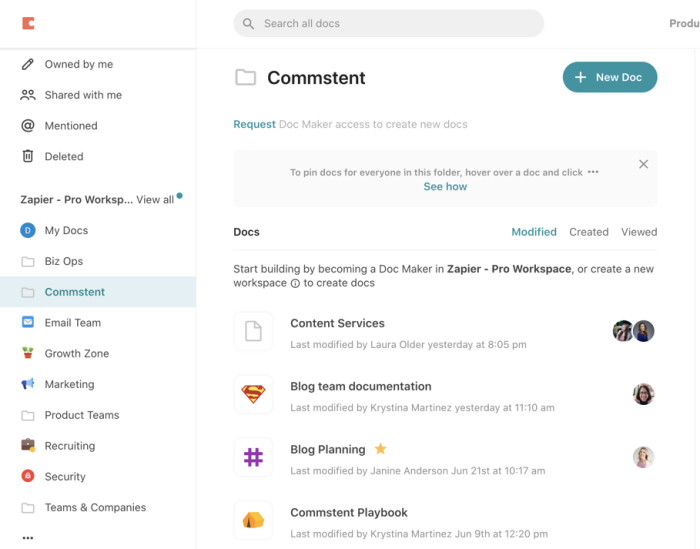Before working at Zapier, I was at an eight-person company. So before I started, all I could do was think about the 400 some-odd difference in size—I had no idea what to expect.
Of course, I survived, but the transition from a small company to a big one definitely involved a learning curve. If you’re about to find yourself in the same situation, here are a few things you can expect—and how you can prepare.
More legacy documentation
The first week at a new job is always overwhelming. At a small company, it usually involves reviewing a few docs and then talking to…everyone. But at a bigger company, you’ll find yourself with all of the documentation. Which is a good thing!

You need to set aside time for all the reading you’ll have to do. I spent hours my first week reading about everything from company values and department-specific goals to project flow and style guidelines. But as anyone who’s ever crammed for a test knows, just reading the docs doesn’t mean retaining said info—not to mention utilizing it.
I recommend doing some serious organizing. Here’s what I did.
-
I created bookmark folders on my Chrome work account to save pages by topic. (You could also use a read-it-later app.)
-
For any documentation that seemed like I’d need to come back to, I added it to my work notes app.
-
I blocked time on my calendar four weeks after my start date to skim through the docs again, now with the deeper understanding that could only come with time.
Side note: separate your work browser account from your personal one, so it’s easier to find the work stuff you need. This post about managing multiple Google accounts can help.
More relationships to build
At the smaller company I used to work at, I was able to build meaningful relationships with everyone—literally everyone, since there were only eight of us. One of my major concerns for my transition to Zapier was building relationships and making myself an essential part of the team when there were hundreds of employees.
Building relationships—especially cross-functional ones—at a bigger company won’t happen as naturally. You’ll need to go out of your way to make it happen. Here’s what I did that worked well:
-
I scheduled one-on-one meetings with teammates who I knew I would work with on a regular basis. This allowed me to build personal relationships with them and better understand how I would fit into the team’s work.
-
I asked those folks if there was anyone else they’d recommend I speak with. It’s kind of like networking, but within your company: use the connections you have to see who else you might connect with.
-
I hunted down the company org chart (which shows everyone’s names and roles) and referred back to it before meetings. That offered the context I needed to be able to speak to each person in a way that would offer them value.
You’ll also likely find that bigger companies have interest-based groups—whether that’s a Slack channel for people who love dogs, or an employee resource group (ERG) that amplifies the voices of an underrepresented group. Joining in on those conversations is a great way to build relationships, both personal and professional.
A bigger tech stack
When I transitioned into my role at Zapier, I doubled the number of apps I needed to use every day. I went from needing to know Slack, HubSpot, Zendesk, and Jira to learning new apps in all categories: a new CMS, a design tool, a project management app, a database, and more.
Navigating new apps can be…a lot. But the best way to learn is to just click around. Start by setting aside time on your calendar to play around with each app. Read a few tutorials if it’s helpful.
Once you feel semi-comfortable with the basics, be intentional about learning how your company uses the app. For example, if it’s a project management tool, look at some of the projects and see how they’re organized: how do they use tasks, due dates, and subtasks? Do they tag each task? Do they use the comment feature? Every company uses apps differently, so get the lay of the land by reviewing.
Slack is a whole different ball game at Zapier compared to my old company. At Zapier, we use emoji like it’s our job (which it kind of is, now that I write it down), which wasn’t a big part of communication at my old job. So even though I thought I was coming into Zapier as a Slack expert, I had to be intentional in figuring out how Zapier uses it to communicate.
More process-oriented project management
As a company grows, processes become more important. It can feel overly bureaucratic at times, but the alternative would be complete chaos. So as you move into your new role at a bigger company, be intentional about learning the project flow. I found two ways to make this happen:
-
Documentation. Most process-oriented companies will have documentation about those processes. Review the docs and keep them handy. Or, if they don’t exist, create that documentation. It’ll benefit you as you learn the processes, and your team will love you for it.
-
Process guide. If you can’t find documentation—or even if you can—ask someone to be your “process guide.” I was working on my first big project, and I finished one of the items only to realize I had no idea how to mark it as done. I reached out to my process guide, Hannah, who immediately showed me the ropes. Violà: problem solved immediately, no rifling around in a sea of documentation to figure it out.
More resources
So far, I’ve talked about all the hard stuff involved in moving to a bigger company. Now it’s time to talk about the perks. At a bigger company, it’s likely you’ll have way more resources to take advantage of. I’m talking standard stuff like health insurance, 401k matching, and parental leave but also more unique perks like a professional development budget or daycare reimbursement.
Some of these perks might seem over the top, but make sure to review everything that’s available to you—even if you get a few dollars a month off a service you already use, for example, it adds up.
And it’s not just financial benefits: you’ll also have more people available to you. That means less figuring stuff out on your own, so my advice: ask all the questions. For example, on day one in my new role, I couldn’t figure out how to log in to our company server. Instead of flailing for an hour to figure it out, I just asked our internal technical support team, and that was that.
Hopefully these tips help you sleep a little better the night before you start your new big-company job. Before you know it, you’ll feel right at home.
[adsanity_group align=’alignnone’ num_ads=1 num_columns=1 group_ids=’15192′]
Need Any Technology Assistance? Call Pursho @ 0731-6725516







